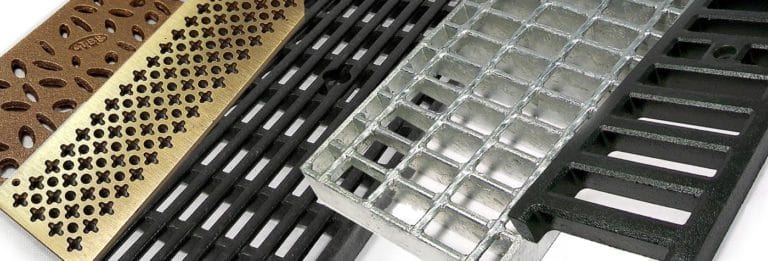Name that Grate! A Replacement Grate Guide
Share

We are often asked to help customers find replacement grates for their systems. If you find yourself in this situation, below are some ways that you can get the information you need that will help us to identify the grate. Keep in mind, you don’t need to have answers for every category but the more information you can provide, the easier it is to identify the grates/system.
Not all grates are made the same. Drainage grates come in many styles shapes and materials.

Grate Material
It helps to know what the existing grate is made of. Some of the typical materials include galvanized steel, ductile iron, plastic, stainless steel, bronze, aluminum, cast iron, or fiberglass.

Maker’s Mark
Make note of any distinguishing marks or logos on the grates and/or trench channels. Any numbers or letters can be surprisingly helpful.
Taking pictures similar to these can also be helpful when identifying a replacement grate.

Traffic
What application is the grate being used in? Is it for a driveway, kennel, highway, brewery, pool… etc.?
The reason you’re replacing grates could provide the opportunity for us to help you find a better option.
Weighted Decision
What is the heaviest traffic/weight that will cross the grates? We have had people say that it’s only going to be cars and pickups crossing their drainage, but it only takes one delivery truck to break down your system. Replacing the system then involves jackhammers and excavators. Better to plan ahead than to have costly repairs later.
Extreme Conditions
What are you sending down the drain? It helps determine what material the grates should be made of. We’ll recommend different options that can hold up to extreme temperatures, chemicals, or other conditions such as coastal salt water.
The experts at TDS can help you find the right drains to fit your plan and budget. Contact us for a free quote or for further information on drainage solutions visit TrenchDrain.com or DrainageKits.com


Measuring
Measuring the grates seems easy enough but something as simple as the height or width of a grate can be misconstrued depending upon the area of the grate being measured. Grates come in many different sizes, shapes, and profiles.
Each measurement is important in determining whether the new grates will sit in the channel properly. To make sure everyone is on the same page with each dimension, a simple diagram can be used with reference points.
If the channel is already in the ground, you can put the tape measure across the top with and without the grate

Measuring the Grate
- Width – Top of grate: it’s helpful to know if the grate covers the sides of the drain
- Width – Underside (from flange to flange) *
not all grates will have flanges - Height of the grate and/or flange
- Length of the grate
A customer provided this diagram with the grate dimensions. It was extremely helpful in determining an adequate replacement for an obsolete system.
Measuring the Channel
- Width – Top of channel (outside dimension)
- Width – Inside dimension of the channel (where the grate rests)
- Height of the chair or ledge that the grate sits on
The experts at TDS can help you find the right drains to fit your plan and budget. Contact us for a free quote or for further information on drainage solutions visit TrenchDrain.com or DrainageKits.com
Feel free to contact us if you have any questions.
Phone: 610-882-3630
Email: Shop@trenchdrain.com
Click here for a fast and free quote!
